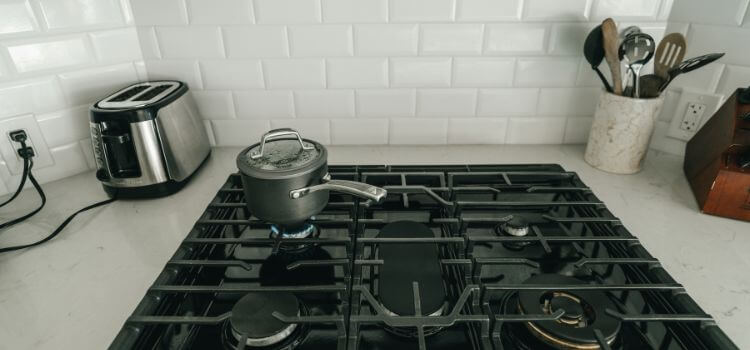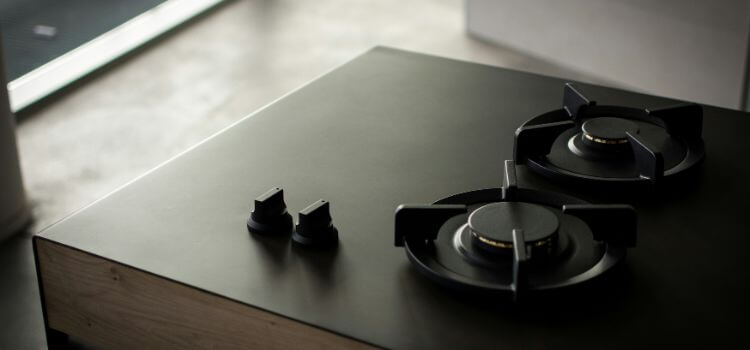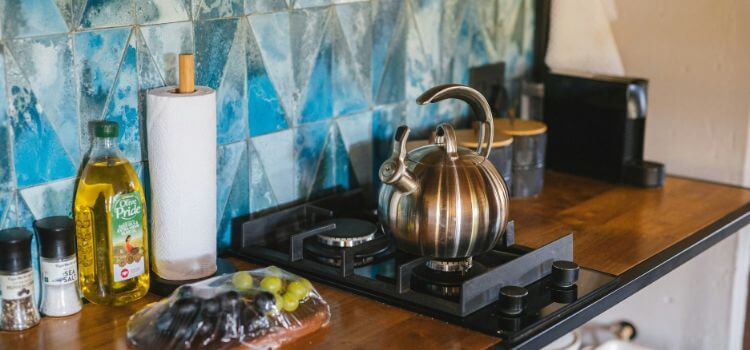As an Amazon Associate, I earn from qualifying purchases

Yes, you can use the stove top if the oven is broken. The stovetop can be a suitable meal alternative when your oven is not working.
While the oven is commonly used for baking and roasting, the stovetop can handle a variety of cooking methods, including boiling, simmering, sautéing, and frying. Adjusting your recipes and cooking techniques accordingly is essential, but the stovetop can still provide a functional cooking option.
You can continue preparing meals by utilizing pots, pans, and other cookware that can be used on the stove, even if the oven is out of commission. Just be mindful of the differences in heat distribution and adjust your cooking accordingly.
Safety First: Assessing Your Kitchen Appliances
Before using your stove top when the oven is broken, it’s crucial to ensure the safety of your kitchen appliances.
Identifying Common Issues With Ovens And Stovetops
When facing appliance issues, check for common problems like faulty heating or gas leaks.
Precautionary Measures Before Using A Malfunctioning Appliance
- Inspect for visible damages before operating the stovetop.
- Avoid using it if there are unusual smells or sounds.
- Keep a fire extinguisher close by as a safety measure.
Understanding The Connection: Stove Top And Oven
Using the stovetop can save the day when your oven is out of commission. The stove top offers versatile cooking options from boiling to sautéing, ensuring you can still prepare meals effectively. Understanding the connection between the stovetop and oven lets you make the most of your kitchen appliances.
Understanding the Connection: Stove Top and Oven How Stove Tops and Ovens Work Together Stove tops and ovens are essential kitchen appliances that work in tandem to provide a seamless cooking experience. The stove top is designed for direct heat cooking, utilizing gas or electric burners to heat pots and pans. At the same time, the oven serves as an enclosed space for baking, roasting, and broiling. When using the oven, the heat is distributed evenly, allowing for thorough cooking of more extensive food items. The connection between the stovetop and oven is crucial for a well-rounded culinary experience, as each component complements the other in creating various dishes.
Independent Systems: When One Can Work Without the Other While the stovetop and oven are often used in conjunction, it’s important to note that they are independent systems that can function separately. Even if the stove is broken, the stovetop can provide cooking options using pots and pans on the burners. This independence allows for continued meal preparation, even if the oven is temporarily out of commission.
Conversely, the oven can also be used independently for baking and roasting without the stovetop. When the oven is not working, the stovetop can still be a valuable tool for cooking a wide range of dishes. Understanding the capabilities of each appliance can help you navigate kitchen challenges and continue to create delicious meals, even without one component.
Electric Ranges: Separating The Burners From The Oven
Electric Ranges: Separating the Burners from the Oven
Electrical Wiring In Electric Ranges
Electric ranges have separate electrical wiring for the burners and the oven.
If the stove is broken, you can still use the stovetop.
Using The Stove Top Independently On Electric Models
- Turn the burner knob to the desired heat level.
- Set your pan over the flame and begin preparing food.
Remember, always follow safety guidelines when using the stovetop independently.
Gas Ranges: The Interdependence Dilemma

When your oven is broken, using the stove top of your gas range becomes a dilemma. The interdependence of the two components makes it only possible to use one with the other. Getting your oven fixed as soon as possible is recommended to avoid inconvenience.
Gas Ranges: The Interdependence Dilemma Gas Flow and Control in Combined Units
When a gas oven breaks down, it’s natural to wonder if you can still use the stovetop. Many modern kitchens feature combined gas ranges with an oven and stovetop, leading to the interdependence dilemma. Gas flow and control in combined units can pose a challenge when one component malfunctions. In such cases, it’s essential to understand how the gas flow and control system are interconnected between the oven and stovetop. Gas ranges typically share a standard gas supply line, so a malfunction in the oven can impact the stovetop’s performance. When the stove is broken, the gas supply to the oven and stovetop remains connected, raising potential safety concerns.
Potential Risks When Using a Gas Stove with a Broken Oven
When the oven is broken and the gas range is still used for stovetop cooking, several possible risks may arise. These include gas leaks, uneven gas distribution, and the risk of fire hazards. With the gas flow and control system compromised due to the broken oven, there’s an increased likelihood of gas leaks, which can lead to serious safety hazards in the kitchen.
The uneven gas distribution between the oven and stovetop can also result in inefficient cooking and potential safety risks. In conclusion, when a gas range oven is broken, it’s crucial to consider the interdependence dilemma and possible risks associated with using the stovetop. Understanding the interconnected gas flow and control system in combined units is essential for ensuring the safety and functionality of a gas range in such situations.
Troubleshooting Common Oven Problems
When your oven breaks down, it can be a significant inconvenience, mainly if you rely on it for daily cooking. However, before rushing to call a repair technician, it’s essential to troubleshoot the issue to determine if the stovetop can still be used while the oven is out of commission. Below, we’ll walk you through the steps to diagnose the issue with your oven and determine if the stove top is affected.
Diagnosing The Issue With Your Oven
If your oven is malfunctioning, the first step is to diagnose the problem. This can be done by checking for common issues like a broken heating element, a broken thermostat, or a malfunctioning control panel. The power source and circuit breaker must also be inspected to rule out electrical issues.
Determining If The Stove Top Is Affected
Once you have identified the issue with your oven, it’s essential to determine if the stove top is still operational. In most cases, the stovetop functions independently of the oven, so if the issue is confined to the stove, you should be able to use the stovetop without any problems.
Cooking Alternatives: Working Around A Broken Oven

When your oven is out of commission, it can be frustrating, but fear not – there are still ways to whip up delicious meals using your stovetop. Let’s explore some creative cooking alternatives to work around a broken oven.
Creative Use Of Stove Top For Baking And Roasting
You can still bake and roast on the stovetop using a heavy-duty pot or pan with a tight-fitting lid.
Create a makeshift oven by preheating the pot or pan on low heat, then placing your dish inside and covering it with the lid.
Adjust the heat to ensure even cooking, and check your creation periodically.
Kitchen Gadgets To Substitute For An Oven
Think about utilizing an air fryer, toaster oven, or electric skillet as an alternative to a traditional oven.
These gadgets can handle baking, roasting, and even broiling, providing versatile options for cooking without an oven.
Professional Repair Vs. Diy: Making The Right Choice
When dealing with a broken oven, the first question that comes to mind is whether you can use the stovetop instead. However, before making any decisions, it’s crucial to understand the options available for repairing the oven. Professional repair and DIY fixes are the two main choices, each with pros and cons. Let’s explore when to call a professional for oven repair and simple fixes you can do yourself.
When To Call A Professional For Oven Repair
When the oven malfunctions, it’s essential to determine how severe the problem is before attempting fixes. If the problem involves complex electrical components or gas lines or requires specialized tools, it’s best to seek professional help. Additionally, contacting the manufacturer or an authorized service provider is advisable if the warranty is still valid. Hiring a professional ensures safety and expertise, reducing the risk of further damage to the appliance.
Simple Fixes You Can Do Yourself
Some oven issues can be resolved with simple DIY solutions. For instance, if the oven door isn’t closing correctly, adjusting the hinges or replacing the gasket can often solve the problem. Cleaning the oven’s interior, checking and replacing faulty heating elements, and calibrating the temperature settings are common DIY fixes. However, following safety precautions and referring to the appliance’s manual or reliable sources for accurate guidance is essential.
Upgrading Your Kitchen: Is It Time For A New Range?

When your oven breaks down, using the stove top becomes a necessity. However, it may be a sign that it’s time to consider upgrading your kitchen with a new range. Is repairing the old one worth it, or should you invest in a modern stove or oven with advanced features?
Evaluating The Cost-benefit Of Repair Vs. Replacement
Assessing the cost of repairing the old oven versus investing in a new range is crucial. Consider repair costs and the appliance’s age to determine if it’s more economical to replace it.
Modern Features To Consider In A New Stove Or Oven
- Energy efficiency: Look for ranges with Energy Star ratings to save on utility bills.
- Convection technology: Opt for ovens with even cooking and faster baking times.
- Self-cleaning: Choose a stove with self-cleaning features for convenience.
- Innovative technology: Consider stoves with intelligent controls for remote operation.
Upgrading your kitchen with a new range can enhance your cooking experience and add value to your home. Explore modern features and assess the cost-benefit to make an informed decision.
Frequently Asked Questions
You can still use the stove top if the oven is broken. The oven and stovetop are independent equipment, so the stovetop should still work. Just make sure to use proper cookware and follow safety precautions.
You can still use the oven if the stove top is cracked. The oven is separate from the stovetop, so it should still function properly. However, it’s essential to be cautious and consider repairing or replacing the cracked stove top for safety.
Yes, you can use a stovetop while the oven is on. However, it is essential to use caution and ensure that cookware or utensils on the stovetop do not touch the stove or surrounding areas. This can prevent heat transfer and potential hazards.
The oven may not work due to a faulty heating element or control panel. It’s a common issue that a professional technician can fix.
Conclusion
A broken oven doesn’t necessarily mean you can’t cook on the stovetop. You can still whip up delicious meals for yourself and your family with some creativity. However, it’s essential to prioritize safety and take precautions to avoid accidents.
Remember always to keep an eye on your cooking and follow instructions carefully. Happy cooking!
As an Amazon Associate, I earn from qualifying purchases
Leave a Reply